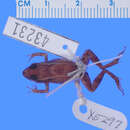Description
provided by AmphibiaWeb articles
Eleutherodactylus pinchoni is a species of very small frogs (adult males average 16 mm, adult females average 20 mm) that occur syntopically with three other species, E. martinicensis, E. johnstonei, and E. barlagnei. According to Kaiser et al. (2003), E.barlagnei is the sister species of E. pinchoni. E. pinchoni can be distinguished from these other species by its medium-sized head and hindlimbs. Dorsal coloration occurs in varying shades of brown, creating multiple linear patterns across the back. The venter and underside of the species vary in color from light orange to bright red-orange.The call of this species is very distinct; unlike any other Guadeloupean frogs, the vocalization of E. pinchoni consists of a single note. This one note is repeated for an average duration of 145 ms. Using sonogram data, it has been determined that the frequency and amplitude of this call undergoes no variation throughout its entire sequence (Kaiser et al. 2003).Populations of E. pinchoni living in lowland forests and near the peak of La Soufreire volcano have exhibited distinctly different calls. Whether this is due to an unusual ecotype or a completely new species remains unknown.As of May 2002, the species was listed as a conservation and legislative concern on multiple websites.Etymology Eleutherodactylus pinchoni was named for Pere Robert Pinchon in recognition of the help he provided Albert Schwartz in his fieldwork in the French Antilles. Pinchon worked in the Seminaire College Forte de France on Martinique, and was widely acclaimed for his assistance in many different areas of fieldwork (Kaiser et al. 2003).
- Breuil, M. (2002). ''Histoire naturelle des amphibiens et reptiles terrestres de l'Archipel Guadeloupeen. Guadeloupe, Saint-Martin, Saint-Barthelemy.'' Patrimoines Naturels, 54, 1-339.
- Kaiser, H., Murdoch, J. T., Boistel, R., and Breuil, M. (2003). ''Eleutherodactylus pinchoni.'' Catalogue of American Amphibians and Reptiles. Society for the Study of Amphibians and Reptiles, 765.1-765.3.
Distribution and Habitat
provided by AmphibiaWeb articles
Country distribution from AmphibiaWeb's database: Guadeloupe.Eleutherodactylus pinchoni is found throughout the Basse-Terre region of Guadeloupe, an island in the French West Indies. This distribution (elevation ranges from 180 to 1467 m) presents a possible threat to the species' ultimate survival (see Trends and Threats below). The type locality of E. pinchoni was discovered at an elevation 600 feet (183 m), three kilometers west of Grande Café in Guadeloupe (Kaiser et al. 2003).
Life History, Abundance, Activity, and Special Behaviors
provided by AmphibiaWeb articles
Like the other frogs in this genus, this frog is a direct developing species. Eggs develop directly into sub-adult post metamorphic frogs.
Life History, Abundance, Activity, and Special Behaviors
provided by AmphibiaWeb articles
In some areas of the Basse-Terre, the geographic range of E. pinchoni approaches the habitat of E. johnstonei. During the 1960s, it was observed that in regions of high E. pinchoni populations, their numbers were dramatically reduced when groups of E. johnstonei entered the habitat (Breuil 2002). Although communities of all four syntopic species have been found to exist, Breuil's observations allude to the possibility that E. johnstonei present a threat to E. pinchoni populations, as well as to its sister species, E. barlagnei (Kaiser et al. 2003).
Eleutherodactylus pinchoni
provided by wikipedia EN
Eleutherodactylus pinchoni is a species of frog in the family Eleutherodactylidae. It is endemic to Guadeloupe and known from the Basse-Terre.[1][3] Common name Grand Cafe robber frog has been coined for it (type locality is near "Grand Café").[3]
Etymology
The specific name pinchoni honors Robert Pinchon, French priest and professor who settled in Martinique in 1945 and assisted Albert Schwartz on his expeditions.[4]
Description
Eleutherodactylus pinchoni is a small frog: males measure 14.4–16.0 mm (0.57–0.63 in) and females 15.2–20.2 mm (0.60–0.80 in) in snout–vent length; the smallest gravid female was 16.6 mm (0.65 in). The snout is acuminate. The tympanum is visible and almost circular. The fingers are long, slender, and unwebbed, but have moderately well-developed discs. The toes are of moderate length and have vestigial webbing. The dorsum is very finely granular. Dorsal coloration is rich, dark wood brown, with variable patterning displaying four basic types. The most common pattern is a pair of relatively broad dorsal chevrons and—usually—a diagonal flank bar from each end of the second chevron into the groin. Some specimens also have two chevrons, but the posteriormost of which cuts off a middorsal patch of reddish-brown pigment in the sacral area. Instead of chevrons, some specimens have a pair of reddish-brown dorsolateral stripes. Finally, some frogs have a pair of dorsolateral lines as well as an irregular pale median dorsal stripe. The ventrum is orange, but this color may be almost completely obscured by overlying dark brown mottling, blotches, or stipples.[2]
Habitat and conservation
Natural habitats of Eleutherodactylus pinchoni are mesic forests and rainforests at elevations of 0–1,250 m (0–4,101 ft) asl. It also survives in secondary forest. It is a terrestrial frog. Males call from the ground or low vegetation, and the eggs are laid on the ground and on bromeliads.[1]
Forest habitat suitable for Eleutherodactylus pinchoni is small in area and continues to decline in quality. It is also threatened by pollution from pesticides used in banana plantations, introduced predators (particularly rats, cats and mongooses), and the introduced frog Eleutherodactylus johnstonei that appears to be displacing it.[1]
References

- license
- cc-by-sa-3.0
- copyright
- Wikipedia authors and editors
Eleutherodactylus pinchoni: Brief Summary
provided by wikipedia EN
Eleutherodactylus pinchoni is a species of frog in the family Eleutherodactylidae. It is endemic to Guadeloupe and known from the Basse-Terre. Common name Grand Cafe robber frog has been coined for it (type locality is near "Grand Café").
- license
- cc-by-sa-3.0
- copyright
- Wikipedia authors and editors

